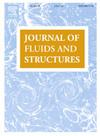在低雷诺数(150)条件下横向摆动的三个串联圆柱体之间的流体与结构相互作用
IF 3.4
2区 工程技术
Q1 ENGINEERING, MECHANICAL
引用次数: 0
摘要
基于有限体积法,使用 OpenFOAM 对三个串联圆柱体的流动诱发振动(FIV)进行了数值研究。分析了间距比从 2 到 6 的三个串联圆柱体在 150 低雷诺数和 2-16 的减速度范围内的一自由度动态响应。本研究讨论了流体力学系数、响应振幅、振动频率、尾流结构和涡度分解的结果。虽然流向间距比保持不变,但三个圆柱体之间交叉角的动态演变导致了唤醒干涉模式的切换。两层涡旋在远侧尾流中合并为二级涡旋,二级涡旋的能量高于两层涡旋。上游气缸的流体力学系数和响应振幅随速度降低的变化趋势与孤立气缸相似。相反,由于屏蔽效应,中间和下游圆柱体的阻力明显降低。特别是在间距比很小的情况下,中间圆筒的阻力变为负值。同时,在高速降低时,升力系数和响应振幅均高于孤立气缸。在振荡过程中,三个串联气缸间歇地形成一个三角形构型。本文章由计算机程序翻译,如有差异,请以英文原文为准。
Fluid-structure interaction among three tandem circular cylinders oscillating transversely at a low Reynolds number of 150
The flow-induced vibration (FIV) of three tandem circular cylinders is numerically investigated using OpenFOAM based on the finite-volume method. The one-degree-of-freedom dynamic response of three tandem circular cylinders with a spacing ratio ranging from 2 to 6 is analysed at a low Reynolds number of 150 over a reduced velocity range of 2–16. The results of hydrodynamic coefficients, response amplitude, vibration frequency, wake structure, and decomposition of vorticity are discussed in this study. Although the streamwise spacing ratio is constant, the dynamic evolution of the crossing angles among three cylinders leads to the switching of wake interference mode. The two-layered vortices are merged into secondary vortices in the far wake, and the energy of secondary vortices is higher than the two-layered vortices. The upstream cylinder exhibits a similar trend as an isolated cylinder in terms of the variations of hydrodynamic coefficients and response amplitude with the reduced velocity. In contrast, the middle and downstream cylinders experience a significantly lower drag due to the shielding effect. Particularly at small spacing ratios, the drag on the middle cylinder becomes negative. At the same time, the lift coefficient and response amplitude are higher than those of an isolated cylinder at high reduced velocities. The three tandem cylinders intermittently form a triangular configuration during the oscillation.
求助全文
通过发布文献求助,成功后即可免费获取论文全文。
去求助
来源期刊

Journal of Fluids and Structures
工程技术-工程:机械
CiteScore
6.90
自引率
8.30%
发文量
173
审稿时长
65 days
期刊介绍:
The Journal of Fluids and Structures serves as a focal point and a forum for the exchange of ideas, for the many kinds of specialists and practitioners concerned with fluid–structure interactions and the dynamics of systems related thereto, in any field. One of its aims is to foster the cross–fertilization of ideas, methods and techniques in the various disciplines involved.
The journal publishes papers that present original and significant contributions on all aspects of the mechanical interactions between fluids and solids, regardless of scale.
 求助内容:
求助内容: 应助结果提醒方式:
应助结果提醒方式:


